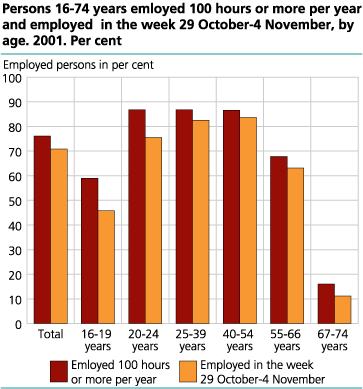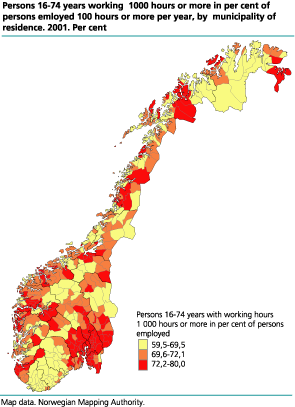Content
Published:
This is an archived release.
Three out of four work 100 or more hours per year
About three out of four persons aged 16-74 years had at least 100 hours paid work in 2001. 80 percent of men and 72 percent of women were employed 100 or more hours during the year. Of all employed persons, 26 percent had working hours of less than 1000 hours per year.
This is illustrated by figures on employed persons in the year from the Population and housing census 2001. The statistics on persons 16-74 years employed 100 or more hours during the year of census, is supplementary to figures for employed persons during census week, 29th October to 4th November, previously published by Statistics Norway. Working hours per year are calculated on the basis of data from several registers.
Employed persons in census week and during the whole year
There were altogether 2 442 000 persons aged 16-74 years that were employed at least 100 hours during 2001. These persons are referred to as employed persons in the year of census. During census week, there were 2 275 000 persons in employment (of at least one hour in that week). There is therefore a difference of 167 000 persons or 7.4 percent, about the same for men and women. The percentage of employed persons in census week was 71, versus 76 during the year. During census week there were 11 percent of employed persons in the age group 67-74 years while 16 percent were employed at least 100 hours during the year. For the age group 16-19 years, the corresponding figures were 46 and 59 percent. The difference between employment during census week and during the year was therefore greatest for the youngest and oldest, i.e. those who do not normally work throughout the year.
Most employed persons in Sogn og Fjordane and Akershus
We find the highest percentages of employed persons in Sogn og Fjordane and Akershus. These counties also have the highest percentages of employed persons during census week. There was relatively little variation among counties with regard to the difference between employment percentages during the year and in census week, however the difference was greatest in Finnmark. In this county we also find the municipality where the difference was greatest. In census week, Kautokeino had the countrys lowest employment percentage, 58, while 73 percent were employed at least 100 hours during the year. The difference between employment percentages during the year and in the week is above the national average for the majority of municipalities with low employment percentages in census week.
Most men with long working hours
For the entire age group of 16-74 years, 74 percent had working hours of 1000 hours or more per year. 80 percent of men worked more than 1000 hours per year while the percentage among women was 67. The difference among employed persons with more than 1300 working hours per year is even greater: 72 percent for men and 54 percent for women.
Nine out of ten youths work less than 1000 hours per year
Although almost 60 percent of all persons aged 16-19 years were employed at least 100 hours per year, only 10 percent of them worked 1000 hours or more and 5 percent worked at least 1300 hours. For employed persons aged 67-74 years, 26 percent worked 1000 hours ore more.
Most people with long working hours in Oslo and Akershus
We find most persons who worked 1000 hours or more per year in Oslo and Akershus. In these counties, particularly women worked a lot. In Oslo there was as much as 75 percent of women with working hours of more than 1000 hours. Aust-Agder and Vest-Agder had the lowest percentages. Finnmark has the lowest percentage of men with employment of 1000 hours or more.
Many persons employed in domestic trade, hotels and restaurants, have short working hours
Within domestic trade, hotels and restaurants, only 62 percent worked more than 1000 hours in the year. There were also relatively many persons employed in the primary industries that worked less than 1000 hours. The highest percentage of employed persons that worked 1000 or more hours was within oil and gas extraction and financial intermediation.
Many combine employment and education
About 86 percent of all persons registered as students at universities and colleges at the first October 2001 were also employed at least 100 hours during the year. Among pupils at upper secondary schools and at folk high schools, 53 percent had employment of more than 100 hours per year. However, as much as 72 percent of employed pupils worked less than 500 hours and only 12 percent worked more than 1000 hours. 43 percent of students worked more than 1000 hours per year. The employment percentage for 16 year-old pupils/students was 30, increasing with each successive year and reaching 87 percent for 20-year olds. It is worth noting that the group pupils/students, does not only comprise those with education as their most important activity, but also persons pursuing supplementary education related to their work.
Tables:
- Table 1 Persons 16-74 years, total and employed 100 hours or more per year, by sex, age and education level. 2001. Numbers and per cent
- Table 2 Persons 16-74 years employed 100 hours or more per year, by working hours per year, sex and age. 2001. Numbers and per cent
- Table 3 Persons 16-74 years employed 100 hours or more per year, by working hours per year, industry and sector. 2001. Numbers and per cent
- Table 4 Persons 16-74 years employed 100 hours or more per year, by sex, working hours per year, industy and sector. 2001. Per cent
- Table 5 Pupils and students 16-74 years, total and employed 100 hours or more per year, by sex, age and type of school. 2001. Numbers and per cent
- Table 6 Persons 16-74 years emloyed 100 hours ore more, total and pupils 2, by working hours per year and industry. 2001. Numbers and per cent
- Table 7 Persons 16-74 years, total and employed 100 hours ore more per year, by sex and place of residence. County, municipality and urban district. 2001. Numbers and per cent
- Table 8 Persons 16-74 years employed 100 hours or more per year, by sex, working hours per year and place of residence. County, municipality and urban district. 2001. Per cent
- Table 9 Persons 16-74 years employed 100 hours ore more per year, by industry and place of residence. County, municipality and urban district. 2001. Per cent
- Table 10 Persons 16-74 years employed 100 hours or more per year, by sex, working hours per year and place of work. County, municipality and urban district. 2001. Per cent
- Table 11 Persons 16-74 years employed 100 hours ore more per year, by industry and place of work. County, municipality and urban district. 2001. Per cent
- Table 12 Persons 16-74 years employed 100 hours or more per year, by sector and place of work. County, municipality and urban district. 2001. Numbers and per cent
- Table 13 Persons 16-74 years, total, employed 100 hours or more per year and employed in the week 29 October-4 November, by sex and age. 2001. Numbers and per cent
- Table 14 Persons 16-74 years emloyed 100 hours or more per year and employed in the week 29 October-4 November, by sex, age and industry. 2001
- Table 15 Persons 16-74 years, total, employed 100 hours or more per year and employed in the week 29 October-4 November, by place of residence. County, municipality and urban district. 2001. Numbers and per cent.
Contact
-
Statistics Norway's Information Centre
E-mail: informasjon@ssb.no
tel.: (+47) 21 09 46 42


